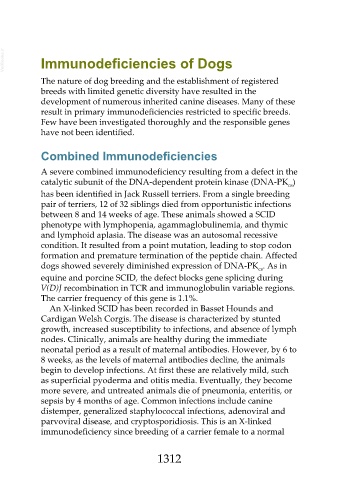Page 1312 - Veterinary Immunology, 10th Edition
P. 1312
VetBooks.ir Immunodeficiencies of Dogs
The nature of dog breeding and the establishment of registered
breeds with limited genetic diversity have resulted in the
development of numerous inherited canine diseases. Many of these
result in primary immunodeficiencies restricted to specific breeds.
Few have been investigated thoroughly and the responsible genes
have not been identified.
Combined Immunodeficiencies
A severe combined immunodeficiency resulting from a defect in the
catalytic subunit of the DNA-dependent protein kinase (DNA-PK )
cs
has been identified in Jack Russell terriers. From a single breeding
pair of terriers, 12 of 32 siblings died from opportunistic infections
between 8 and 14 weeks of age. These animals showed a SCID
phenotype with lymphopenia, agammaglobulinemia, and thymic
and lymphoid aplasia. The disease was an autosomal recessive
condition. It resulted from a point mutation, leading to stop codon
formation and premature termination of the peptide chain. Affected
dogs showed severely diminished expression of DNA-PK . As in
cs
equine and porcine SCID, the defect blocks gene splicing during
V(D)J recombination in TCR and immunoglobulin variable regions.
The carrier frequency of this gene is 1.1%.
An X-linked SCID has been recorded in Basset Hounds and
Cardigan Welsh Corgis. The disease is characterized by stunted
growth, increased susceptibility to infections, and absence of lymph
nodes. Clinically, animals are healthy during the immediate
neonatal period as a result of maternal antibodies. However, by 6 to
8 weeks, as the levels of maternal antibodies decline, the animals
begin to develop infections. At first these are relatively mild, such
as superficial pyoderma and otitis media. Eventually, they become
more severe, and untreated animals die of pneumonia, enteritis, or
sepsis by 4 months of age. Common infections include canine
distemper, generalized staphylococcal infections, adenoviral and
parvoviral disease, and cryptosporidiosis. This is an X-linked
immunodeficiency since breeding of a carrier female to a normal
1312

